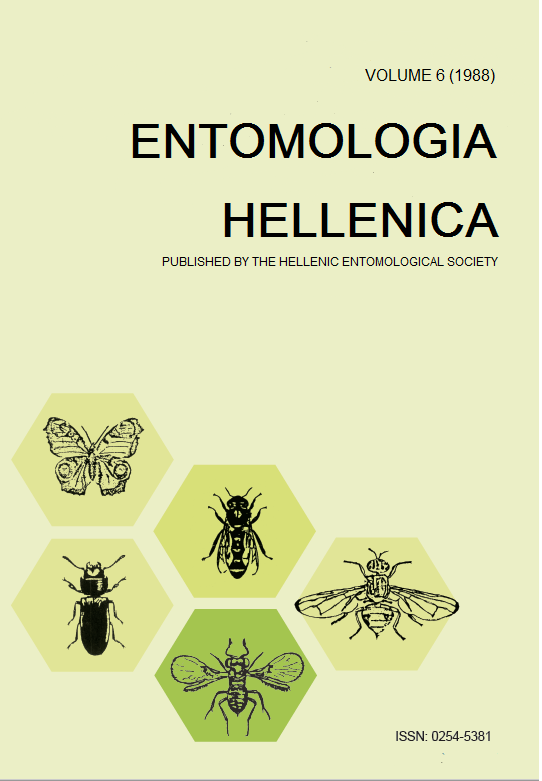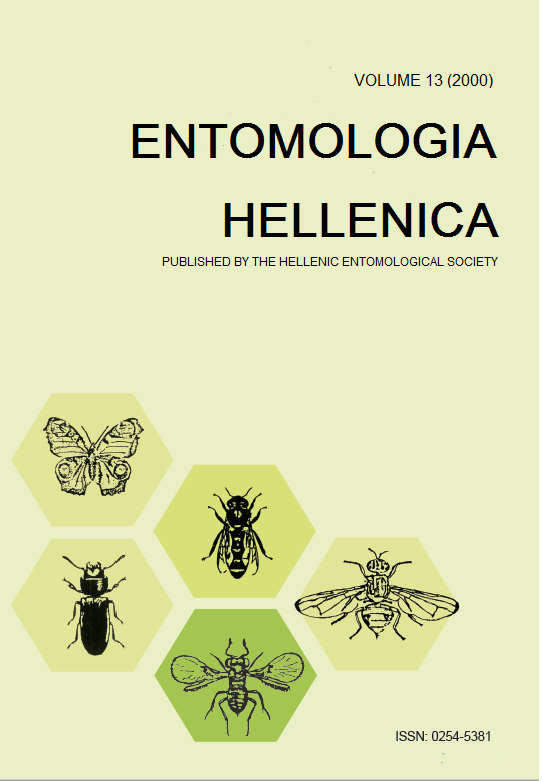Abstract
In late August 1988, the author noticed the presence of Corythucha ciliata (Say) (Hemiptera: Tingidae) in many plane trees of the following locations of northwestern Greece: 1) City of Kastoria, on 22.VIII.1988, along the coastal road of the city’s peninsula in Lake Orestias. Along this road, trees near the Panaghia Mavriotissa church were heavily infested, while trees further away were less so. Infested trees were also noticed along the quay of the northern end of the city. 2) Zagori, Epirus, on 24. VIII.1988, on the banks of the river Voidomatis, where the river meets the road between the villages Aristi and Papingo. The degree of infestation varied between adjacent trees. 3) Zagori, Epirus, on 25.VIII.1988, the single plane tree in the middle of the square of the village Eptahori. 4) City of Yannina, on 26. VIII. 1988, several single trees in the Kastro section of the city and also trees along the banks of the lake bordering the city. As heavily infested were recorded trees having most of their leaves chlorotic in the largest part of their laminae. On the underside of leaves that could be reached from the ground live adults, exuviae of immature stages and dark sports typical of excrement and of oviposition sites of Tingidae were found. On certain leaves more than 10 live adults per leaf were counted in Kastoria and Yannina. The identity of the species was determined by the author on adult specimens from Kastoria preserved dry and in ethanol. The fact that the infested locations were tens of kilometers apart and at considerably differ ent altitudes, leads to the conclusion that C. ciliata must have crossed the Greek northwestern border not less than two years ago. It is suspected that the insect entered Greece by natural spread from neighboring Albania. Examination by the author of plane trees in towns and villages of the Pella and Kilkis prefectures near the Yugoslavian border, showed no infestation. C. ciliata is of nearctic origin. In the northeastern and northwestern United States it is a pest of sycamore, Platanus occidentalis L., which is its preferred host plant, but also feeds on ash, hickory and also on mulberry. In Europe the host plants of preference are Platanus X acerifolia (Afton) Willd. and P. orientalis L., while such other broad-leaved trees as Brussonetia pap•rifera and ash are also reported as able to support the insect. The insect entered Europe and was noted first in Italy in 1964. Its spread was rather rapid, so that by 1986 it had spread to all the regions of Italy. In 1976 chemical control tests against it were reported from Hungary. Its presence in Yugoslavia was reported in 1972, in France in 1977, in Spain in 1981, in Switzerland in 1983 and in Austria in 1984. It is considered one of the three most important insects infesting the leaves of plane trees in Italy and generally very destructive. The adult insect is approximately 3 to 3.5 mm long and has reticulate front wings and reticulate expansions of the pronotum. The pronotum is yellowish, largely expanded on the sides which are transparent, and has a median vesicated process. The front wings are subquadrangular and have a proximal vesica which is globular and more or less smoky towards its internal margin. Two to three generations per year have been reported in Italy, same as in the northeastern United States. Hibernation takes place in the adult stage, mostly under loose bark at the basal part of the trunk or in other protected places nearby. In spring, the adults move to the young leaves, where they lay their eggs on the under side of the blade where the immature stages feed and develop and the long-lived adults remain feeding and reproducing. The feeding punctures cause chlorosis which starts from the basal part of the leaf and may expand to almost the whole leaf. On the underside of leaves, where the insect lives in colonies, there are usually numerous small dark spots. Heavily infested species of Platanus, in addition to extensive yellowing, may undergo premature leaf drop. In Italy and especially in urban areas, C. ciliata continues to cause concern because of the weakening of plane trees which predisposes them to attacks by other enemies. There is no doubt that the spread of C. ciliates in Greece will also be fairly rapid. The authorities should take advantage of the extensive work done in Italy, to further develop effective and ecologically sound control measures. Determining the resistance to the insect of Plalanus stock available in Greece should be among the projects to be encouraged.





